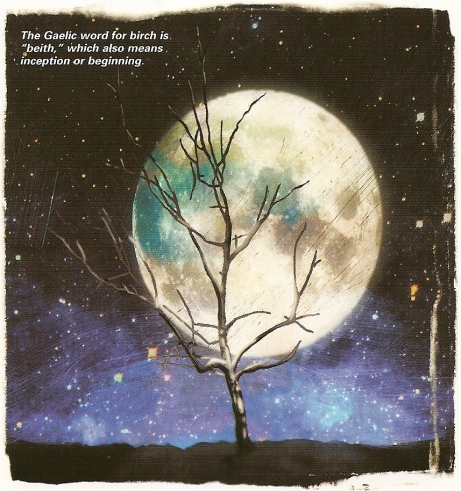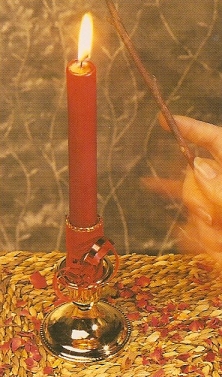
“Lucina” by Sandra M. Stanton
“Lucina themes are banishing, kindness, charity, health and protection. Her symbols are candles (light sources). Lucina means light, and judging by Her description and attributes, it is very likely that this Swedish Goddess was the prototype for Saint Lucy. Lucina is a mother and guardian, offering fertility, protection, and well-being. In worship, Lucina is often represented by a simple, lit candle.
To chase away winter’s oppression and darkness, Saint Lucy’s festival is one of lights and charitable acts. Saint Lucy is the patroness who protects against winter throat infections, and commemorating her (or Lucina) today keeps one healthy.
Begin the day in Swedish tradition by lighting a candle to represent the Goddess’s presence. After this a breakfast of coffee, saffron buns, and ginger cookies is traditional fare. Coffee provides energy to give of yourself, saffron is often used is healing spells, and ginger promotes success in all your endeavours today.
To manifest Lucina’s energy and keep the Goddess close by today, carry luminescent stones like moonstone or cat’s eye with you, then visit hospitals or elder homes in the spirit of giving of yourself. Lucina will bless those you visit, and you, with well-being, productivity and safety.”
(Patricia Telesco, “365 Goddess: a daily guide to the magic and inspiration of the goddess”.)

“St. Lucia” by Joanna Powell Colbert
According to Patricia Monaghan, “The little red ladybug was the emblem of this Roman Goddess, later merged with Juno and Diana, and even later converted to Christianity as St. Lucy. The early Italic Lucina was a Goddess of light and therefore – because birth is the first time we see Her – of labor and childbed as well. She was variously honored in September and in December – still the times for festivals of Lucina as the candle-bearing saint; Her holidays were enforced by the superstition that any work done on those days would be undone by the morrow” (p. 199).

“Juno” by Gustave Moreau
Thalia Took writes: “Lucina is a Roman Goddess of Light, a Moon-Goddess who is especially a Birth-Goddess, for when a baby is born it is brought into the light of the world for the first time. As such, this epithet was applied to both Juno and Diana in their capacity as Childbirth-Goddesses, and together these Goddesses were sometimes called the Lucinae. It could also be used as an epithet of Hecate as Moon-Goddess. The name is probably from the Latin lux, ‘light’ or ‘daylight’, from which we get words like lucid, luminous, and that’s right, the name Lucifer, ‘Bringer of Light’ used of the planet Venus as the morning star. (It was also, incidentally, the name of a 4th century bishop who founded his own sect, the Luciferians. Just imagine—’Bishop Lucifer’!) As the Goddess of Childbirth, Lucina protected pregnant women and the newborn child, and She was invoked by women who were having difficulty conceiving and who wanted children.
An ancient bronze mask of Juno Lucina shows Her with Her hair in tight stylized braids; a tiny crescent moon is engraved on Her forehead, as if it is an ornament dangling from Her parted hair. A different image of Her shows Her with a child on Her lap, with two more at Her feet, and holding a flower as a reminder of how She alone conceived Her son Mars, with the help of a magical flower given to Her by Flora.
Juno Lucina had been worshipped from an early age at a grove on the Cispian Hill, one of the heights of the larger Esquiline Hill in Rome. Her worship was said to have been instituted by Titus Tatius, King of the Sabines who had ruled jointly with Romulus, the legendary founder of Rome, making it very old indeed and possibly pointing to an origin for Lucina in a Sabine Moon-Goddess. The slightly later (and still mostly legendary) King Servius Tullius of the 6th century BCE was said to have begun the custom of offering a coin (I’d guess that it was traditionally a silver one, as the shiny disk of the coin could then be symbolic of the Moon) to Juno Lucina on the birth of a child, which would indicate some sort of shrine there at the time. Her main temple was built on the same site in 375 BCE, and dedicated on March 1st. In later times a large wall was added enclosing both the temple and the grove that grew on the slope of the hill. This grove was evidentally an important part of Her worship; some authorities believe that Lucina was originally derived from lucus, grove, and this grove had an ancient and celebrated tree on which offerings of locks of hair were made by the Vestal Virgins, perhaps as acknowledgement that as avowed virgins they had chosen not to be mothers.
The Matronalia, or the Festival of Mothers, was held at this temple on the anniversary of its founding. Some said it was instituted in honor of the Sabine women who were instrumental in brokering peace between the warring Sabines and early Romans. On the day of the festival, the matrons (married women) of Rome processed to the temple, where offerings and prayers were made to Juno Lucina and Her son Mars: at home, it was the custom for the women to receive gifts from their husbands, and a feast was held in which the matron waited on the slave women.

Juno Lucina was invoked during childbirth for an easy delivery and healthy child; when worshippers called on Lucina, they let their hair loose and untied any knots in their clothing as an act of sympathetic magic, to symbolically loosen any hindrances to childbirth and allow the energy to flow. When the child was born an altar was set up to Her in the atrium of the house, and a lectisternium, (or probably more properly, asellisternium, which was for Goddesses) or banquet was given to Her.
She was equated with the Greek Eileithyia. In ancient Egypt was a city by the name of Nekheb, of whom the patron Goddess was Nekhbet, the Egyptian Childbirth-Goddess; when the Greeks took over in Ptolemaic times, they renamed the city Eileithyia after their Birth-Goddess; and when the Romans annexed Egypt, they called it Lucina.
Sources:
Monaghan, Patricia. The New Book of Goddesses and Heroines, “Lucina”.
Took, Thalia. Thaliatook.com, “Lucina“.
Suggested Links:
Benko, Stephen. The Virgin Goddess: Studies in the Pagan and Christian Roots of Mariology.
Brockway, Laurie Sue. The Goddess Pages: A Divine Guide to Finding Love and Happiness, “Saint Lucy (Lucina)” (p. 183 – 189).
Colbert, Joanna. Gaiantarot.typepad.com, “Why We Honor St. Lucia” and “More about Saint Lucia“.
Fitzgerald, Waverly. Schooloftheseasons.com, “St. Lucy’s Day“.
Lanzillotta, Peter E. Interfaithservicesofthelowcountry.com, “Santa Lucia: The Saint for the Season of Light“.
Loar, Julie. Goddesses for Every Day: Exploring the Wisdom & Power of the Divine Feminine, “Juno Lucina“.
Lundy, John Patterson. Monumental Christianity, or, the Art and Symbolism of the Primitive Church.
Murphy-Hiscock, Arin. Pagan Pregnancy: A Spiritual Journey from Maiden to Mother, “Lucina“.
Theoi.com, “Eileithyia“.
Wikipedia, “Lucina (goddess)“.

































